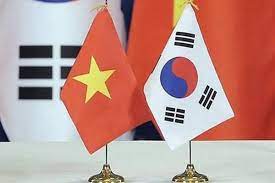
Feedback
Did you find what you were looking for?
Can we ask you a few more questions to help improve the VNTR?
Tariff commitments in VKFTA are negotiated on the basis of tariff commitments in the ASEAN - Korea FTA (AKFTA), with a higher liberalization level. VKFTA will have further cut a number of tariff lines that have not been cut in AKFTA, specifically as follows:
To sum up the commitments in VKFTA and AKFTA:
 The Vietnam - Korea Free Trade Agreement (VKFTA) was signed on May 5, 2015 and officially took effect on December 20, 2015. In comparison to the ASEAN-Korea FTA (AKFTA), Vietnam and Korea give more incentives to each other in the fields of goods, services and investment in the VKFTA. However, VKFTA does not replace AKFTA, but both of these FTAs are in effect and businesses can choose to use which FTA is more beneficial.
The Vietnam - Korea Free Trade Agreement (VKFTA) was signed on May 5, 2015 and officially took effect on December 20, 2015. In comparison to the ASEAN-Korea FTA (AKFTA), Vietnam and Korea give more incentives to each other in the fields of goods, services and investment in the VKFTA. However, VKFTA does not replace AKFTA, but both of these FTAs are in effect and businesses can choose to use which FTA is more beneficial.
Progress
Origin criteria: According to the provisions of the Agreement, goods will be considered originating in a party (Vietnam or Korea) if one of the following conditions is met:
In general, the Rules of Origin in VKFTA are stricter than those in AKFTA but still relatively simple. To enjoy tariff preferences under VKFTA, goods need to meet one of the following criteria:
Goods that do not meet the change of classification requirement are still considered originating if:
Regulations of origin: Goods are still considered originating whether they are manufactured or processed in Khai Thanh Industrial Park on the Korean Peninsula from materials exported from one party (Korea is the main one) , which is then re-imported back into that party, provided that the total value of the non-originating inputs does not exceed 40% of the FOB value of the good.
Certificate of Origin Procedures: Regarding the procedures for granting preferential certificates of origin (C/O), the FTA still applies the process of certificates of origin issuance through a authorized state agency as in previous signed VKFTAs that Vietnam is implementing.
In particular, the Agreement allows exemption from submission of Certificates of Origin for imported goods with a customs value of not more than USD 600 (FOB value), or a higher level if the importing country allows.
Chapter 1: General provision
Chapter 2: National treatment and Market access on goods
Tariff schedule of Vietnam (section A, section B)
Tariff schedule of Korea (section A, section B)
Chapter 3: Rules of Origin and Origin procedure
Chapter 4: Customs administration and Trade facilitation
Chapter 5: Sanitary and phytosanitary measure
Chapter 6: Technical barriers to trade
Chapter 7: Trade remedies
Chapter 8: Trade in Service
Chapter 9: Investment
Chapter 10: E-commerce
Chapter 11: Competition
Chapter 12: Intellectual property
Chapter 13: Economic cooperation
Chapter 14: Transparency
Chapter 15: Dispute settlement
Chapter 16: Exceptions
Chapter 17: Institutional and Finance provisions
Others related document
Agreement arrangement for economic cooperation pursuant to Chapter 13 of the VKFTA Agreement
Chapter on Services in VKFTA is divided into 02 parts:
The two parties commit to common regulations and obligations to ensure the interests of service and service providers of each party when accessing the service market of the other party. Each party shall provide the other party's service providers and service providers with the following basic benefits:
Commitment to market access The Services Chapter in VKFTA applies a choose - give approach similar to that in the WTO, i.e. each party will have a list of areas of commitment which lists open sectors and their level openess of commitment, sectors not listed as uncommitted.
For sectors with commitments, depending on the content of specific commitments, each party will not issue or maintain measures affecting the other party's service providers, including restrictions on the number of service suppliers; restrictions on transaction value; restrictions on the total number of service operations or the number of service outputs; restrictions on the total number of human resources to be recruited; restrictions on the type of business; restrictions on foreign capital contribution.
In comparison with the service market opening commitments of Vietnam and Korea in WTO and AKFTA:
Each party undertakes to protect the interests of investors and the investments of investors of the other party through the obligations specified in the Chapter on Investment, in which, there are 4 basic obligations:
Ministry of Industry and Trade
Disclaimer: All information on this website is presented for consulation purpose only and does not constitute legal advice. All legal responsibility rests solely on the user. Users should not act upon any information obtained through this website without prior verigication with competent national authorities.
The website has been developed under Web Content Accessibility Guidlines (WCAG) 2
Viet Nam Ministry of Industry and Trade. All rights reserved.

Did you find what you were looking for?
Can we ask you a few more questions to help improve the VNTR?

0 of 12 answered


